UPDATE: For our recipe for kimchi, see “Homemade Kimchi” (June 26, 2011).
While the Chinese stir-fry vegetables, Koreans pickle them. Wikipedia explains the history of kimchi:
Early kimchi was made of cabbage and beef stock only. Red chili, a New World vegetable not found in Korea before European contact with the Americas, was added to kimchi recipes some time after 1500. Red chili pepper flakes are now used as the main ingredient for spice and source of heat for many varieties of kimchi. In the twelfth century other spices, creating flavors such as sweet and sour, and colors, such as white and orange, were added.
There are many varieties of kimchi. The Kimchi Field Museum in Seoul has documented 187 varieties of kimchi, and there are an almost infinite number of variations upon the basic varieties.
Kimchi’s Health Benefits
Kimchi is a natural probiotic. At early stages in its pickling, lactic acid bacterial species such as Leuconostoc mesenteroides and Lactobacillus plantarum dominate. [1] As kimchi ages, more species appear and the bacterial environment diversifies.
There is evidence that eating kimchi helps against autoimmune disorders and allergies. [2, 3] It’s also plausible that kimchi would help against bowel conditions, since those often feature a limited repertoire of gut flora. (See Bowel Disease, Part IV: Restoring Healthful Gut Flora, July 27, 2010.)
Kimchi Side Dishes
Kimchi is usually served as a side dish when fresh. Here are a few photos from our local Asian supermarket.
When most people think of kimchi they think of cabbage. Here is a whole row of cabbage kimchi:
Cabbage kimchi is made by soaking the cabbage in salt, squeezing the water out, and layering the salted cabbage with a marinade. Marinades may contain shredded radish, chili powder (which gives the red color), garlic, garlic sprouts, and green onion.
Often the marinade will include oyster or anchovy as a flavor enhancer: you can see a sign for oyster cabbage kimchi in the above picture. These are better quality kimchi; poor quality kimchi may use MSG.
However, there are many other types of pickled kimchi besides cabbage. Here is another picture from our local supermarket:
Along the bottom and upper left are pickled vegetables, on the upper right are fermented seafood. In this picture are probably about 80 different varieties of kimchi.
Here are some examples of what we eat:
On the left is Napa cabbage kimchi, which is for Koreans what salad is to Americans. It includes Korean radish, pepper powder, onion, green onion, apple, pear, sugar, salt, ginger, garlic, salted shrimp, salted anchovy, and oyster sauce. On the right is a spicy radish kimchi.
This is another extremely popular flavor, cucumber kimchi. It’s seasoned with chives, Korean radish, hot red pepper powder, onion, carrot, sugar, salt, ginger, garlic, salted anchovy, and sweet rice flour.
Pickled white radish. One of Paul’s favorites, with a very mild taste; seasoned with cayenne, fish sauce, and salt.
Clockwise from upper left: pickled seaweed (seasoned with vinegar, wine, sugar, cayenne, scallion, oil, green pepper, garlic, and ginger); pickled garlic cloves (seasoned with vinegar, salt, sesame, panicum, black bean, and miso); seasoned sesame leaves (with cayenne and garlic); pickled yellow radish; and garlic stem kimchi (flavored with garlic, sesame, and pepper paste).
This last picture illustrates how we often eat vegetables with dinner. We’ll cook an entrée and starch, but serve the vegetables family-style in their original plastic containers; everyone can serve themselves. It makes for a nice buffet of vegetables with very little labor.
Kimchi Soups and Stews
As kimchi gets older, it becomes sour as acidic fermentation products build up, and the mix of bacterial species tends to change to a less probiotic mix.
Older kimchi will therefore be put in soups and stews and boiled to remove bacteria and dilute the sour taste.
Some examples can be seen in this trailer for an upcoming US public television series, “Kimchi Chronicles”. First, a promo introducing the series:
This longer trailer shows an example of using older kimchi as an ingredient in a stew:
How to Make Kimchi
Here’s a video showing how to make kimchi at home:
Conclusion
It’s a good idea to find some flavors of kimchi, or other fermented vegetables like pickles or sauerkraut, that you like. It’s an inexpensive and nourishing way to obtain probiotic bacteria; and a convenient and easy way to eat vegetables!
References
[1] Cho J et al. Microbial population dynamics of kimchi, a fermented cabbage product. FEMS Microbiol Lett. 2006 Apr;257(2):262-7. http://pmid.us/16553862.
[2] Won TJ et al. Modulation of Th1/Th2 Balance by Lactobacillus Strains Isolated from Kimchi via Stimulation of Macrophage Cell Line J774A.1 In Vitro. J Food Sci. 2011 Mar;76(2):H55-H61. http://pmid.us/21535768.
[3] Won TJ et al. Oral administration of Lactobacillus strains from Kimchi inhibits atopic dermatitis in NC?/?Nga mice. J Appl Microbiol. 2011 May;110(5):1195-202. http://pmid.us/21338447.







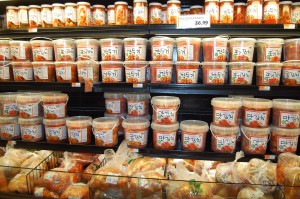
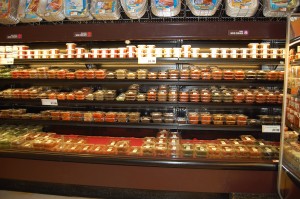
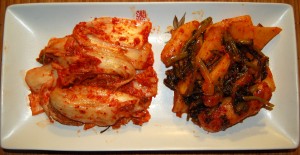
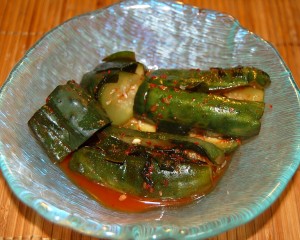
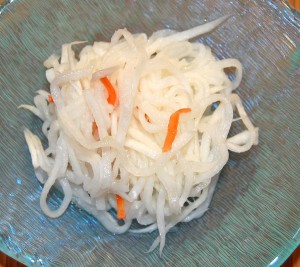
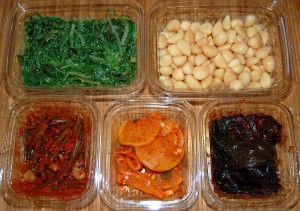




I cooked up some radish/cayenne kimchi with ground beef – Husband, upon arriving home – “What is that smell?”. (not appreciativey). But it tastes good – will be dinner tomorrow after 24 hour fast.
Kimchi flavors can be strong, but ground beef should be a good moderator.
It took me years to adjust my taste to kimchi … it’s sort of the opposite of the sweet tastes Americans are used to.
Enjoy your fast!
Alright, gotta try it now!
How long does it take for the balance of bacteria in kimchi to be more bad than pro-?
I have made it with Napa Cabbage and other veggies and spices, mainly for the probiotics. How long do the most beneficial bacteria survive before the kimchi is best converted to soup or other dishes? Once I know this I can plan batch sizes accordingly so I use most of it up in a timely fashion.
Thanks for the great ideas!
Hi Eric, Rodney,
Koreans generally go by taste … when it turns sour, put it in soup.
Thanks Paul,
The video mentioned they used “Last year’s” kimchi, so I guess it probably doesn’t sour for at least a few months. Time to experiment!
2-3 weeks after first exposure to oxygen is more like it … traditionally kimchi was made in the fall after harvest, kept outdoors in sealed clay pots, and lasted the winter … cabbage gets soggy once it’s exposed to air.
I think “last year’s” means that it was frozen or kept in an air-tight container to preserve it.
Also, if the kimchi you buy wasn’t fresh at purchase, it may go sour in a week or less.
Too bad there are no asia-shops were I live. The only fermented food available around here is sauerkraut.
I mean, I love sauerkraut, but I think I would adore kimchi even more..
This is a very timely post for me as I have been staring at a huge jar of radish kimchee I bought about 6 weeks ago(and relegated it to the basement refrigerator) trying to decide if it is still good or if I needed to throw it out. Our Asian store is known for their homemade kimchee but having never tried it I still hadn’t worked up my courage to taste it and my husband (who is the radish lover) turned up his nose at it. If it has turned (it has not been opened) and I use it in a soup am I getting any benefits from it (aside from the benefits of just eating vegetables)?
Hi Sara,
There may be a few extra vitamins, such as vitamin K or vitamin B12, generated by the bacteria. But mostly, it will be vegetables.
Best, Paul
Making kimchi is super easy. I’ve been doing it for almost 2 years now. Most of the recipes out there use too much salt. I posted a Kimchi 101 article to help beginners get started on this healthy hobby.
http://criticalmas.com/2011/03/kimchi-101/
I started making Kimchi a month or two ago and love it. Before that I’ve made my own Sauerkraut and Cortido, which is a bit like a Mexican Kimchi I guess. For me the sourer the better – I leave my Sauerkraut about a year.
I recently bought your book but haven’t had time to read it yet. Judging by the blog though it should be great. I appreciate all your efforts.
Best wishes to you both.
There is a potential downside — stomach cancer. There are every high rates of stomach cancer in Asian countries where pickled vegetables are regularly consumed. There are numerous studies that have found strong associations with such consumption and upper GI cancers. There is speculation that the cause might be nitrosamines (and or nitrites) formed during the pickling (and/or chewing) process. Some studies find lacto fermentation reduces nitrites (to NO, or nitric oxide) while some find that pickled vegetables contain high concentrations of nitrosamines… most of these studies are Asian with only Abstracts in English… In any case, NO when consumed with fat (in which it dissolves) readily formed nitrosamines in simulated stomach conditions… For what it’s worth, I eat sauerkraut regularly but only with a fat soluable antioxidant (like turmeric) added.
Thanks, Dan. I’ll look into that.
Best, Paul
Speaking from complete ignorance except as a consumer and just guessing here – but maybe we’ll find it’s not the fermented food, but additives to it, or to other portions of the Asian diet, in combo with the ferments that’s the cause. If it’s not home-made, there can be lots of undesirable stuff in preserved Asian foods.
I agree jack,
unless a store bought product explicitly says that it contains (live) bacteria,
then you can be pretty certain that it does not.
The store bought “ferments” have generally been pasteurised (killing all bacteria) & usually have additives like preservatives.
One reason the store bought stuff is produced/processed this way, is to prevent it exploding on the shelves (from gases building up).
I find ready-made kimchi at the Korean markets to be overly salty, and I’m speaking as a person who likes to eat salty foods. Also, I once asked a kimchi maker at the market if she put sugar in her recipes, and I was told that she did put not only sugar but corn syrup. So ever since then I only buy kimchi in jars with ingredients listed.
I’m part Taiwanese and in Taiwan if I remember correctly, Minnan Taiwanese in the countryside would partially dry some of the vegetables/ fruits like daikon or green melons before pickling them. I think by doing so the pickled produce tends to taste fresher but not as crunchy. Anyways, I wonder if the drying process affects the nutrients in any way, good or bad. They tasted great though!
Thanks for an excellent article, as always. I’d love to hear your thoughts on the stomach cancer angle, at some point in the future. (Thanks to Dan for bringing it up!)
Also: I sent this post to my mother, who commented that most people add sugar to kimchi these days. Since kimchi is normally eaten in small or moderate quantities, I’d speculate that the sugar content shouldn’t pose a big problem for metabolically healthy individuals.
Do you have any thoughts on whether adding sugar to kimchi would impact its probiotic effects (positively or negatively)? Would it allow certain bacteria to grow more effectively?
A kimchi/fermented food and stomach cancer link? Man that’s depressing.
Interestingly, it looks like H.Pylori infection rates are very high in Korea at 46.6% (http://www.ncbi.nlm.nih.gov/pubmed/11595059) versus around 25% in the West (http://en.wikipedia.org/wiki/Helicobacter_pylori#Epidemiology) and there is a strong association between infection and stomach cancer (http://www.ncbi.nlm.nih.gov/pubmed/9703356).
I’d love to know more about this – forgoing that fermenty goodness is not something I’d like to do!
I too had read different research studies that suggested stomach cancer being more prevalent in Japan and Korea, where people consume pickled, salty dishes on a regular basis. This was when I was a student in Microbiology, but I distinctly remembered it because I stopped eating pickled veggies regularly after reading those articles.
Russians also love pickled foods. But Russian sauerkraut, for example, is a lot less acidic/ vinegary and more crunchy than German sauerkraut. My Russian grandmother’s recipe even called for lingonberries for added sweetness.
Hi Jae,
Sugar is sometimes used for flavoring, but any sugared kimchi should be eaten immediately. It won’t age well.
I’ll do a kimchi / fermented foods health analysis before long. It’s an important question.
Best, Paul
I had thought the high dietary intake of salt preserved fish was the reason for the high levels of GI cancers is some Asian countries, becsaue of something I’d read a few months ago. But Dan’s earlier comment pushed me to do a quick search.
Anyway, it seems it’s the processing/preserving methods that generate carcinogenic N-nitroso properties of certain foods. But the list of foods that contain N-nitroso are quite common, so it’s another question of dosage.
http://www.ncbi.nlm.nih.gov/pmc/articles/PMC2786176/
“As a result, it was concluded that N-nitroso compounds are among the most potent dietary carcinogenic agents or chemicals.”
Looking forward to a more in-depth post on the issue, Paul!
Thanks for helping me with research, Robert.
It’s an interesting question, and important. The interaction of foods with cancer is something I’ve been meaning to get to, so this will be a good place to start.
Hi Paul,
is regular japanese tsukemono (the easy, salted kinds) a source of probiotics?
Also, I have natto bacillus/nattokinase, but I’m interested in knowing (given that you would have an idea) if I can ferment other things than soy beans with it, and if it in that case would still be a source of K2 vitamin, or that is something derived from the beans only?
I’m planning on trying out kimchi! I helped making it while in Japan, and developed a taste for it then.
Hi Rikke.
japanese tsukemono is just japanese food.
might, antiquity korean spreaded japanese.
Kimchi is Korean food. i think Kimchi is more wonder than natto. you know, natto has one bateria that add on purpose. if you want to know anything(more than natto) derived soy beans, Korean food, you find toenjang
Hi Rikke,
Yes, Japanese tsukemono is pickled and therefore develops lactic acid bacteria such as Lactobacillus plantarum, just like the kimchi side dishes mentioned above. In fact, they’re essentially the same thing.
Bacillus subtilis natto will generate K2 no matter what you use them on. I’m not sure what foods they’ll grow on best: perhaps starches by analogy with the beans? This species is good for fighting fungal infections.
Best, Paul
Hi Paul,
thank you for your answer! I guess I will have to experiment with other things to ferment.
Time for some superfoods!
Jana – didn’t mean to overlook you – I’ll be looking at your question when I research the fermented foods post.
Best, Paul
When I have looked at the kimchi in the Asian market, the ingredients make me leery since some of them look like they may contain gluten (soy sauce, oyster sauce IIRC). I have a book on Korean cooking and the recipe in it definitely had gluten.
Have you found gluten free kimchi? I kind of shrugged it off and quit looking but I would be willing to look again (my wife loves kimchi).
Hmmm … most recipes do contain soy sauce, oyster sauce, fish sauce, or anchovies. But do you know they contain gluten?
I don’t know how to tell if a recipe is gluten-free unless they tell you.
It’s been my experience that most soy sauce available in the U.S. contains gluten. Wikipedia is pretty helpful on the subject. http://en.wikipedia.org/wiki/Soy_sauce
It might be the case that Korean soy sauce is not made with wheat. But as someone who needs to be 100% gluten-free I wouldn’t eat a product that contains soy unless it’s labeled gluten-free.
I am not real fond of the taste of Kimchi that I have purchased, but I have made my own that I like alot. I used to make saurkraut but I find I like the Kimchi better and it is very simple to make.
for anyone interested here is my recipe…the only thing measured is the salt.
2 heads of nappa cabbage sliced thin
grated ginger.. about 1 1/2 inch nob
grated carrots..2 or 3
grated daikon radish about a cup
3 or 4 cloves of garlic chopped
chopped green onions or some regular onions
juice of one lime
a little fish sauce or not….your choice
red pepper flakes and some cayeanne…use as little or as much as you want according to taste.
2 tablespoons salt. The salt must be a kind without additives. I use celtic grey sea salt but pickling salt would work also.
I also use a about 1/2 pkg of vegetable pickling starter but that is not nescesary it just helps get things going quicker.
Knead and squeeze all of the ingredients in order to bring out the liquid. After that stuff into a 1/2 gallon canning jar and set on a plate on the kitchen counter. Don’t screw the lid too tight as it will expand some and the juices probably will seep out, thats why you need to set it on a plate or you will have a mess. Let it sit out until you like the degree of fermentation….usually about 3 or 4 days, then refrigerate…..Tastes very good with eggs or a little thrown in your salad.
Thanks, Terry! I’ve put a link to your comment on the Recipes thread.
Best, Paul
What Peter said about soy sauce and gluten. I haven’t found an oyster sauce yet that doesn’t have gluten, so you can assume that gluten is in there if it’s listed. We use abalone sauce instead in recipes that call for oyster sauce.
I haven’t found an authentic fish sauce that would be a problem. It should be fermented fish, salt and maybe a little sugar.
Any idea why my otherwise healthy stomacch can’t cope with pickled/fermented cabbage?
Doesn’t matter if it’s sauerkraut or kimchi after 3o minutes I can start in direction of the toilet without fail!
And I actually like the taste of both!
Sometimes kimchi has more sugar or other carbohydrates than you might expect! Sometimes it doesn’t wind up the label…
I just bought some kimchi at the supermarket that clearly contained more carbohydrates (likely sugar) than is listed on the jar. I am using a ketogenic diet (CKD, like the Atkins diet) and consuming even tiny amounts of sugar will knock me out of ketosis. I ate about a cup of this supermarket kimchi over the course of 8 hours, and was knocked out of ketosis. That’s a pretty small amount of kimchi, clearly it contains more non-fiber carbs than is listed on the label. Sugar is often added to products to appeal to the masses… the kimchi I bought was super tasty, but I would have avoided it had I known it had enough carbs in it to knock me out of ketosis. I wish they were more honest on the labels.
I live in Thailand, and this kimchi is probably made for the large expat Japanese population here in Bangkok. I say this because the label reads KIMCHI in Japanese larger than the labeling in English, Thai, or Korean. While I LOVE kimchi and believe it is the perfect snack for those on a no-carb ketogenic diet like Atkins, South Beach, or CKD, I need to find a local person making kimchi who doesn’t add sugar, or at least keeps the addition of any carbs way down.
Totally bummed about being knocked out of ketosis, it’s very frustrating to be so careful about food intake, then consuming what you’re not supposed to because people want to sneak in some extra secret sugar into something that shouldn’t have it. *sigh*
I guess we’ll have to put up a recipe for home-made kimchi.
That way we can be sure there’s no sugar, gluten, MSG, or other toxins.
Hi again!
I just wanted to make an update on my nattokinase project.
I tried growing it on cooked sweet potato, and it is very doable! In fact it tastes pretty good; may even make the potato slightly sweeter, but I am not sure.
It even pulls some strings similar to those on nattou.
I put pictures on my blog (click my name), if anyone is interested 🙂
I will definitely be testing it on other foods!
Hi Rikke,
I like your thinking!
I can’t stand soy natto, but I think sweet potato natto would be awesome!
Here are Rikke’s relevant posts:
http://ishouldblogthis.blogspot.com/2011/05/my-two-day-project.html
http://ishouldblogthis.blogspot.com/2011/05/report-on-nattouimoimonattou-and.html
http://ishouldblogthis.blogspot.com/2011/05/report-on-nattouimo-part-2.html
I’d love to try this.
Thanks, Rikke!
My pleasure! I will warn you though, that it still has the “footy” smell and taste, so if that is the part of soy nattou you dislike, I would suggest against it; though it can’t hurt to try 😉 (And you can still taste it is sweet potato)
I’m currently experimenting with butternut squash. I will post the result tomorrow.
i found some “traditional” recipes for fermented cabbage Chinese style on the web. really easy.
it does not use sugar (the authors actually are pretty adamant about not using sugar in the process & suggested only adding it when you take it out, depending on the personal taste.
but looks like most commercial ones have sugar in.
Hi PHK,
We’ll be posting recipes for homemade kimchi in 2 weeks. You’re right, it’s best with no sugar.
We had some at dinner tonight, it was excellent.
Hey Paul. Take a look at this if links are allowed. Of course it’s a bit over my head, but do you think this suggests there is yeast in kimchi?
http://www.ncbi.nlm.nih.gov/pubmed/18562030
Hi Ellen,
Yes, yeast will always form in plant matter given enough time. But bacteria tends to dominate when it’s young, which is why the yeast species the paper found varied based on the factory. There’s no one species particularly favored by the vegetable.
Hello!! I’m loving your wonderful / informative articles, and as a Korean, this kimchi one can’t make me feel any more glad!!
About the H. Plyori and stomach cancer thing, I know the reason. In Korea, we share our food. We would have big pot of kimchi soup, for example, and we all put our spoons in it and eat it as a family. The bacteria therefore can travel very easily from one person to another. This issue is quite famous in Korea. It’s the reason why modern Koreans are now trying to eat in more “Western way.”
Another reason for the problem is probably the salt content. I think I heard eating too much spicy & salty food isn’t good for your stomach.
But as a conclusion, I’m pretty sure benefits of kimchi is way too superior to be let down by these points!
Some of you are saying that some kimchis are too salty, strong, etc. Just wondering if you’re eating the kimchi with rice ( how it’s traditionally/commonly eaten ) or by itself? As a Korean, I’ve grown up eating kimchi and still do, but never on its own. I eat it as a side with rice and sometimes a protein. Anywho, I was just curious. Cheers!
My grandmother and whole my family have make fermented veggies all the time, they are very traditional in my country and that what my grandmother used to eat during whole winter when they did not have fresh veggies or during the world war II when they did not have any food from store. We do it in different way of cource but it is the same benefit. I would like to ask you about miso since it is fermented food is it ok to eat it when it contain soy or barley? I know that 3 years old miso is very benefical for friendly bacteria and enzymes just want to know if it is ok to consume even if it contains soy and barley. Many thanks
Hi Misa,
I think miso is OK, it’s not a lot of protein. If the dose is low enough toxins are usually not a problem.
Absolutely love kimchi, but it can leave the breath quite aromatic.
An idea for people who hate vegetables, or can’t stand the idea of Kim chi is to use a food dehydrator to make their own greens powder.
I didn’t like any of the greens powder available commerically and I also don’t always have time to get fresh greens for smoothies and salads. What I did do was to buy a food dehydrator to make beef jerkey, then decided if I can do that why not greens!
So purchased organic kale, chard, spinach and dehydrated them and used my coffee blander to make a fine powder. It tastes so good and far better than the commercial stuff- it does not tast GREEN which I find is the predominant taste in the commercial stuff that they try and cover up with stevia and other fruit powders.
Dehydrators are a paleo persons friend!
Paul, I just read through your kimchi post and it makes me want to visit our Korean neighborhood to find a market for some different kimchi and different condiments that you show in the pghotos. My question is about gluten. When you listed some ingredients found in some of the kimchis, I wasn’t sure if gluten could be hiding out. 😉 I have celiac disease, so I want to know what to look for when I get to the Korean markets.
Thank you!
Hi Dede,
I have never seen gluten as an ingredient in kimchis. I would be surprised if that is intentionally included in any of them.